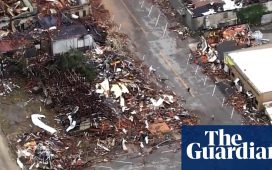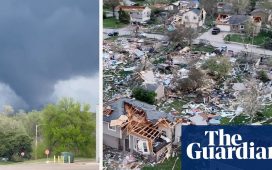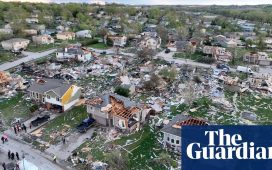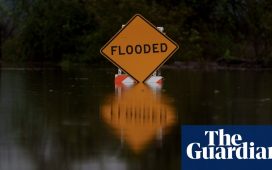MIAMI — As Hurricane Dorian plowed toward the Florida coast on Thursday, the predictions became more dire, the preparations more urgent, the disruptions more immediate.
By the time the storm makes landfall on Monday, forecasters warned, it could be an extremely powerful Category 4 hurricane with sustained winds of 130 miles per hour, driving a deadly storm surge and causing catastrophic damage. Exactly where that would happen was still unclear, so Florida’s entire Atlantic coast was on alert Thursday, with residents from Miami to Jacksonville crowding sandbag-filling stations and rushing to grocery stores.
“It looks like Thanksgiving,” said Elizabeth Eradiri, who works at a Publix supermarket in Fort Pierce. “It didn’t look like this yesterday. They’re buying everything you can think of — but mostly water.”
If the forecast holds, Dorian would be the first hurricane of Category 4 or higher to make landfall on Florida’s east coast since 1992, when Andrew, a Category 5 storm, ripped through the Miami area. But with Dorian spinning and gathering energy about 300 miles northwest of Puerto Rico on Thursday evening, its likely route toward the Bahamas and then the United States mainland remained maddeningly difficult to pin down with any precision.
“It’s too early to make decisions about evacuations,” said Mayor Lenny Curry of Jacksonville. “We may very well find ourselves, at some point in the next 24 or 48 hours, calling for evacuations — depending on what this storm does.”
Even so, Dorian’s impact was already being felt, as Floridians scrapped their Labor Day weekend plans and nervously checked the latest forecasts.
A football game between Florida State and Boise State, scheduled for Saturday evening in Jacksonville, was moved west to Tallahassee and rescheduled for earlier in the day. A Rolling Stones concert in the Miami area that was planned for Saturday night was moved up to Friday, the band announced. And President Trump, who had been planning to travel to Poland for a commemoration of the outbreak of World War II, said Thursday afternoon that he was canceling the trip.
“Our highest priority is the safety and security of the people in the path of the hurricane,” Mr. Trump said.
Forecasting Dorian has been a meteorological struggle for days now. Puerto Rico had been bracing for a direct hit on Wednesday, but the storm skirted the island’s eastern end. It instead hammered St. Thomas in the United States Virgin Islands, where some surprised residents scrambled to install storm shutters in time. Rain kept falling on Puerto Rico on Thursday, leading to some flooding.
Before the storm reached St. Thomas, the National Weather Service was predicting that it would eventually strengthen to Category 2 by the time it reached Florida. By Thursday morning, the agency was talking about Category 4, and a possible landfall as far up the coast as southeastern Georgia, though Florida still seemed likeliest.
“These storms, they’re just very sensitive to small changes,” said Brian McNoldy, a hurricane researcher at the University of Miami.
[What do storm categories mean? Here’s what you need to know.]
Some forecast models suggested a direct blow to Central Florida on Monday. Others foresaw the storm veering to the north or the south. At least one projection suggested that Dorian could stall just off the Florida coast, delaying landfall past Monday.
“It all depends on this dance of the pressure systems around the storm,” said Hugh Willoughby, a meteorologist at Florida International University in Miami. He said he expected “a major hurricane landfall somewhere between where I’m sitting and the Georgia border,” almost 400 miles to the north.
Because of the uncertainty about where the storm would hit, Gov. Ron DeSantis extended an emergency declaration to all 67 Florida counties, as preparations continued up and down the Atlantic coast. In Daytona Beach, city crews cleared storm drains and reduced the water levels in retention ponds to make more room for rain runoff. At Port Canaveral, boat captains were warned not to wait too long to enter sheltered waters. And in Brevard County, east of Orlando, jail inmates filled sandbags for residents.
Closings and cancellations were already being announced. The University of Central Florida, in Orlando, said it would close from Friday evening through at least Tuesday. At Bethune-Cookman University in Daytona Beach, a mandatory campus evacuation was set to take effect on Friday, with classes called off until further notice. Vero Beach officials announced that the city’s parks and beaches would soon close.
But even as officials urged action, they said it was too soon to panic.
“If you have very difficult-to-assemble shutters,” said Mayor Carlos A. Gimenez of Miami-Dade County, “maybe it’s time to start putting a couple of them up. Don’t put them all up yet.”
At an Exxon station in Melbourne, though, public concern was evident. All day, vehicles were lined up bumper to bumper waiting to fill up. The station sold more gasoline in four hours on Thursday than it had all day Tuesday, said Ashli Presnell, an employee who described the scene as “an absolute madhouse.”
“I’ve never seen it this bad,” Ms. Presnell said. “You would think the world is ending right now.”




